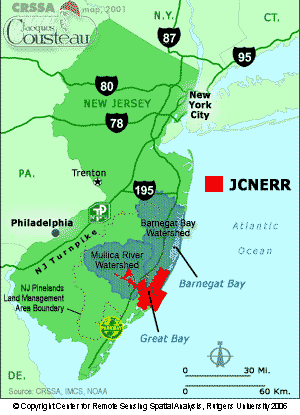Jacques Cousteau National Estuarine Research Reserve facts for kids
The Jacques Cousteau National Estuarine Research Reserve (JC NERR) is a special natural area in southeastern New Jersey. It covers more than 110,000 acres (about 450 square kilometers). This huge area includes land, wetlands, and water habitats. It is all part of the Mullica River-Great Bay Ecosystem.
This reserve has many different types of natural places. You can find pinelands, swamps, and marshes here. There are also sandy beaches and dune habitats on barrier islands. Shallow bays and the coastal ocean are part of it too. Very little of this area has been changed by people. It is one of the most untouched estuaries in the busy northeastern United States.
Contents
What is an Estuary?
An estuary is a place where a river meets the sea. Here, fresh water from the river mixes with salt water from the ocean. This creates a unique environment. This mix of waters makes a very productive ecosystem. It is important for many plants and animals. Life on land and in the sea depends on these special places.
History of the Reserve
The Jacques Cousteau National Estuarine Research Reserve was officially opened on October 20, 1997. It was named to honor Jacques Cousteau. He was a famous ocean explorer and conservationist. The JC NERR is one of 26 such reserves in the United States. These reserves are called National Estuarine Research Reserves (NERRs). They help us use and manage our nation's estuaries wisely.
What the Reserve Does
The main goal of the Jacques Cousteau National Estuarine Research Reserve is to protect estuaries. It works to improve how we manage these important natural places. This is done through three main activities:
- Scientific research
- Education
- Stewardship (caring for the environment)
Scientific Research
Scientists at JC NERR study the estuaries. They look at the physical parts, like the water flow. They also study the chemical parts, like water quality. And they research the living things, like plants and animals. This research helps us understand how estuaries work. It also helps us protect them better.
Education Programs
The JC NERR offers many programs for learning. They have special training for teachers. These programs teach about New Jersey's unique coastal resources. Teachers can then share this knowledge with their students. The reserve also provides training and materials for people who manage New Jersey's coast.
Life on the Edge Exhibit
There is a cool exhibit called "Life on the Edge" at the Tuckerton Seaport. It takes visitors on a virtual journey. You can explore from the start of the Mullica River. Then you travel through the Pinelands. Next, you go into the marsh ecosystem in Great Bay. Finally, you reach the open ocean. This exhibit teaches about the plants, animals, and importance of estuarine habitats.
Who Manages the Reserve?
Many different groups work together to manage the JC NERR. The land within the reserve is owned by state and federal governments. The Institute of Marine and Coastal Sciences at Rutgers, The State University of New Jersey, is the main managing partner.
Other important partners include:
- The New Jersey Department of Environmental Protection
- The Edwin B. Forsythe National Wildlife Refuge
- Stockton University
- The Pinelands Commission
- The Tuckerton Seaport
- The Cooperative Institute of Coastal and Estuarine Environmental Technology
These groups all work together. Their goal is to protect and study this amazing natural area.


